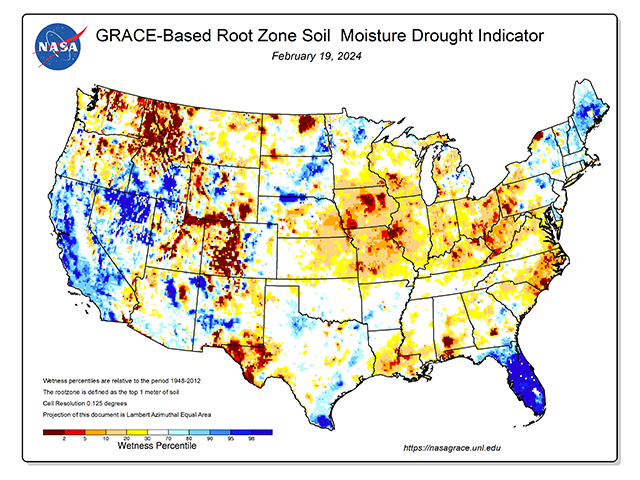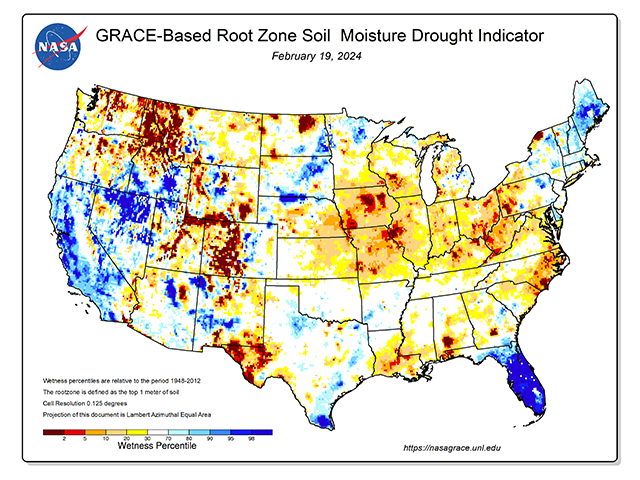Ag Weather Forum
Corn Belt Dryness is a Concern as Spring Gets Underway
A look at soil moisture levels in the central United States at the start of meteorological spring shows low to very low supplies from the surface deep into the moisture profile. That's the conclusion drawn from a review of analysis at various levels, from surface to ground water, produced by the satellite-based NASA-GRACE (Gravity Recovery and Climate Experiment)-F0 project.
The NASA-GRACE F0 root-zone moisture analysis as of Feb. 19, 2024 shows wetness levels in most of the Midwest from 30% of the mean to less than 10% of the mean, using 1948-2012 as the base period. The root zone is defined as the top 1 meter (39.37 inches) of soil.
The fact that the root zone is still dry is impressive, especially because the meteorological winter (December-January-February) featured occasions of heavy precipitation. That was certainly the case in Iowa, where winter precipitation made its way into historical standings. "Iowa experienced an overall wet winter (December was the 27th wettest, January was the 18th wettest and 3rd snowiest)," State of Iowa Climatologist Justin Glisan told DTN in an email.
P[L1] D[0x0] M[300x250] OOP[F] ADUNIT[] T[]
However, even above-average precipitation in the 2023-24 winter season does not make up for years of drought. "We did not get enough precipitation after this extended period of drought/dryness to get moisture deeper in the profile," said USDA Midwest Climate Hub Director Dennis Todey via email to DTN. "Deep soils I would expect are widely drier than usual."
Todey also offered recognition of how unseasonably warm conditions from late January through February brought evaporation into the winter moisture scene. "We usually talk about recharge in the winter without regard for evaporation because colder temperatures don't help evaporate much water," Todey said. "The warm temperatures this winter have been enough to lead to some evaporation and loss of moisture at the surface."
The result is that the U.S. Corn Belt has minimal soil moisture reserves ahead of the 2024 crop season. Precipitation on a just-in-time basis looms as essential with this lack of moisture in the profile. And that situation is likely to show up right at the start during planting unless spring precipitation outperforms most forecasts.
"Unless we get into a wetter pattern, many farmers will be planting into drier profiles," State Climatologist of Iowa Justin Glisan said.
A full explanation of the NASA-GRACE F0 project is available here: https://nasagrace.unl.edu/…
The warm winter also left the Great Lakes with record-low ice cover. More details are available here: https://www.dtnpf.com/…
Despite a January cold spell, the 2023-24 winter season has been warm. Learn more here: https://www.dtnpf.com/…
Bryce Anderson can be reached at Bryce.Anderson@dtn.com
(c) Copyright 2024 DTN, LLC. All rights reserved.






Comments
To comment, please Log In or Join our Community .